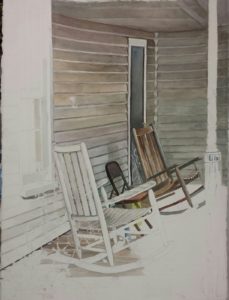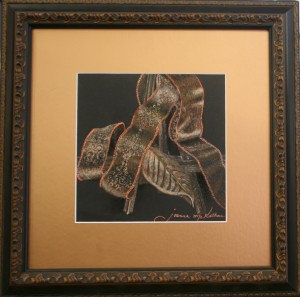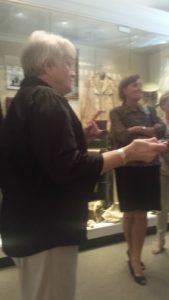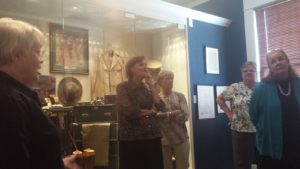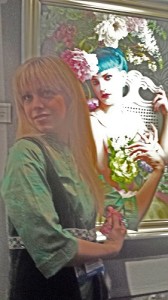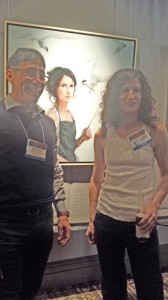…Serendipity!
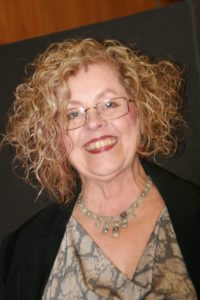
People ask, “What do you do all day long?”
Like yesterday. Valid question. I’m not insulted.
I resisted saying “sippin’ wine and eatin’ cheese.’ Nor did I mention my fantasy of lying in aqua satin gown on a chaise longue in heaven, wielding wand, throwing out star-dust pronouncements, “Well done, Master Painter!”
I wish it were like that. Ever.
Instead, my day went this way. I visited the embroidery shop next door to look for a template for a border on a painting I’m doing for a client, a painting of a lady’s grandmother, a sentimental work, sepia-toned photograph called a brown print. In watercolor I’m to create a look of authenticity, antiquity, as well as a fresh likeness of a young lady. Meeting my new neighbors at the stitch shop, we confessed wanting to wish each other well in our downtown businesses. They listened to figure out how to give me what I needed from one of 25 machines I hadn’t a clue how they’d use.
Returning to my shop, left open too long, pocketbook in full view, I telephoned a customer about an art lesson makeup and learned that her daughter might not want to continue art. Bummer. She loved me, she was just so busy. “It’s criminal,” I say, “she’s so good.” Stuffing my disappointment down, I plan website articles, go to my next joy and next woe. Blogging. A Beast Supreme who chops words up for stew. My computer is Blogging Kitchen where I boil ideas, simmer them into gravy, preferably made from a roux, French style, like my Mom did. Now that I’m ‘into blogging,’ it’s fun. Blogging turns my creative business day into a diary.
Next I sit at my 30 x 36 oil painting of myself on a stretched canvas I’ve been working on for four years. No, I don’t worship myself or think I’m so great–self-portraits are prescribed by Portrait Society of America and top artists as best way to better one’s craft on all portraits. Since the subject is permanently attached, one can keep comparing, contrasting and “seeing” new info pop up. Working ‘from life,’ the best way.
Today, the brushes rebel, the paint globs, and I’ve been told by experts NOT to use turpentine or thinner to rinse (it leaves chemical residue) and ruins the chemical sandwich that is an oil painting, decreasing its longevity. Every morning I research to determine how to give customers paintings that won’t deteriorate, crack or delaminate after 30 years. Pinky finger promise, had I known technical issues would be so daunting, I might never have ventured further…. Today I’m hating withdrawal from the ‘solve-everything-with-a-medium’ high. I check on p.67 of the oil painting book written by expert, check social media daily for input from his feed.
I arrange paints on a color continuum; I’m proud of my collection, now, result of years of conferences and introduction to professional grade products from a national closed group of artists who share best products and practices–museum conservators, art masters who advise manufacturers, as well as art product manufacturer heads who listen to and implement conservators’ knowledge in the marketplace.
I relax into my art bench, new colors spread out on palette, and begin creating. Submerged into the zone, I get the eye lifted in the middle half a centimeter in almost the right color; I soften. I mix a new shadow flesh color using my system and soften the shadow on the chin that was harsh. Success! I bring a shadow to the cheek area, move the frontal plane of my face from center to an angle to the right, facing beyond the falcon to the viewer. I push color on the right-facing eye up to compensate the change. Now the iris is a tad long, so blued eye white reshapes the base of it. With flake white, transparent, I change shadows past the lower left-facing cheek to underlip to a lighter shade (how did I miss that the first 200 times around?) near the lip. I work until soft turns smushy. Advantage lost, I dip in medium, blot out thoroughly, and then clean my brushes using brush soap. Several times, until oil color is gone, brushes re-shaped. I must take care of brushes.
No sooner done than my neighbor walks in with the template they have worked on, one connecting dollops of cut work on sturdy paper on a pad. I show him my young girl drawing, the hand-constructed oval done four times like the matting of the photograph. He is duly impressed. I am impressed with their work–a stencil from the source reduced a tad smaller to 7/8″ inch.
Time to teach class. I have younger students today, plus one older. We have a blast, talk art and art concepts as seriously as adults. I take them to my work area to show them what I’m working on. They are amazed with how I can draw something so big, ask me how.
“Start by doing something smaller,” I say with a smile.
“You have a lot of stuff,” one says.
“You can only comment if you come help me straighten,” I say.
My entourage returns to finish their hour. One makes watercolor spots that bleed together perfectly for the calico cat. The other finishes her colored pencil flowers behind her butterfly, which we all agree look like flower candles in a candelabra. I take pictures of each student with their in-progress work, them, and the picture they work from. My art models, I call them, telling them good-bye.
Now I use the stencil created for me, all I needed to make my own marks regular. It works like a dream, as I manipulate material to fit my size oval (ovals are not uniform measurements, folks). Roughed in in under an hour, what would have taken days and too much erasing otherwise.
“Your life,” a friend says. “Yeah, they moved in right across from me.” I laugh. Amazing, how solutions seem to walk right up when you reach out over fear–fear of losing yourself, your time. Opening yourself up, leaving the safe zone, opening ear and heart to life is key.
Serendipity–solutions arrived today when I was ready for them! Others must wait ’til tomorrow.
Learn more »
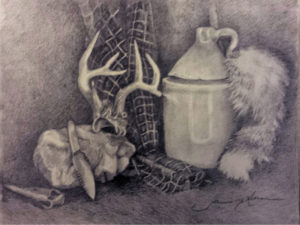

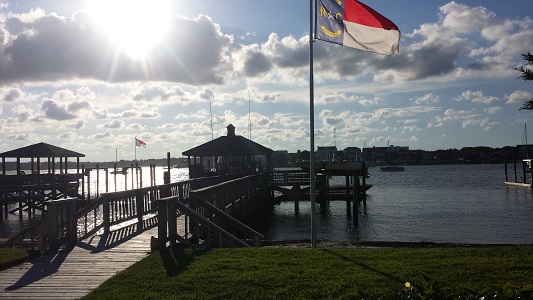
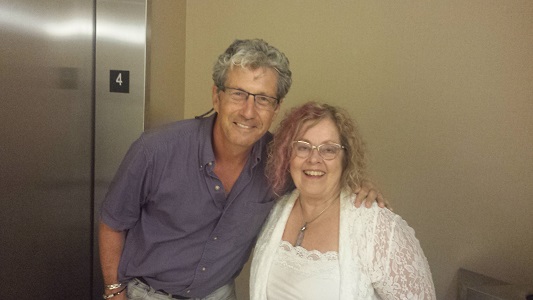
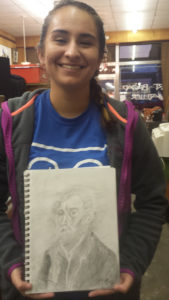
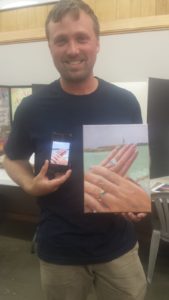
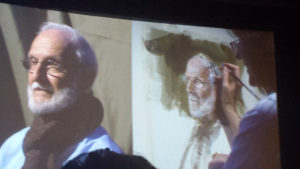
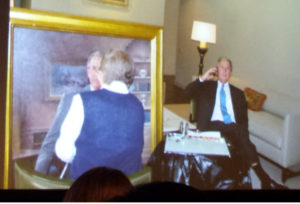 and going to the White House unveiling, and of his eight full-blown attempts to get just the right moment. Sanden is famous for his paintings and books, one of Billy Graham I have seen at The Cove, just outside Asheville. Of painting the richest women in the world. He confessed that his life work had been only 350 portraits as compared to some in our midst’s 600 already. He, like many other artists there, had been a teacher at The Artist’s League, and instrumental in turning the small class format for learning portraiture around a model and a painter into the auditorium format which turned into the: you guessed it….the Portrait Society of America (see their materials for real facts and answers to your burning questions). Several of us deemed this year’s conference of some 800 folks different. Mysteriously wonderful.
and going to the White House unveiling, and of his eight full-blown attempts to get just the right moment. Sanden is famous for his paintings and books, one of Billy Graham I have seen at The Cove, just outside Asheville. Of painting the richest women in the world. He confessed that his life work had been only 350 portraits as compared to some in our midst’s 600 already. He, like many other artists there, had been a teacher at The Artist’s League, and instrumental in turning the small class format for learning portraiture around a model and a painter into the auditorium format which turned into the: you guessed it….the Portrait Society of America (see their materials for real facts and answers to your burning questions). Several of us deemed this year’s conference of some 800 folks different. Mysteriously wonderful.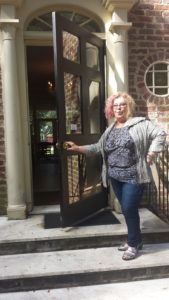 Plus, I got to demonstrate my watercolor skill on the following day, Saturday, April 8, from 10 am until 4 pm, during the 2017 Southern Pines Home and Garden Tour.
Plus, I got to demonstrate my watercolor skill on the following day, Saturday, April 8, from 10 am until 4 pm, during the 2017 Southern Pines Home and Garden Tour.
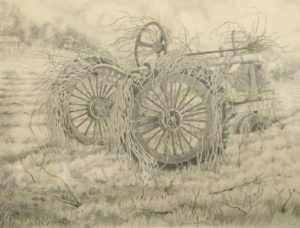 One drawing I did of an old John Deere tractor in a field is all that is left of the real thing. A strip mall in the outskirts of Fuquay-Varina exists there, now, but my drawing, “Reclaimed,” shows it with the Southeastern greenery, briars and vines, growing up through its wheels, seat, and steering wheel. I went every day for a couple of weeks and sat in my car finishing my piece in graphite black and white. So I guess the series began way back when I did that picture.
One drawing I did of an old John Deere tractor in a field is all that is left of the real thing. A strip mall in the outskirts of Fuquay-Varina exists there, now, but my drawing, “Reclaimed,” shows it with the Southeastern greenery, briars and vines, growing up through its wheels, seat, and steering wheel. I went every day for a couple of weeks and sat in my car finishing my piece in graphite black and white. So I guess the series began way back when I did that picture.